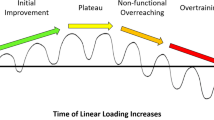Abstract
The effect of initial muscle length on the speed of shortening at different relative loads has been determined for the soleus and flexor digitorum longus (FDL) muscles of the cat. Isometric tetanic force-length relationships for both muscles were similar to those shown previously. The functional length range for FDL occurred at relatively long lengths, from optimum (100%) to 135% of optimum length; however, soleus worked at relatively short lengths from 60% to 110% of optimum length. In FDL the speed of shortening at any given load was relatively constant within the functional range, but at very short muscle lengths the speed of shortening declined. Soleus also showed a decline in the speed of shortening at all loads at short muscle lengths, which included the functional working range of the muscle. Speed of shortening at any given load was maximal at optimum length but tended to decline at low loads and long muscle lengths. It is concluded that in FDL even when the toes are at the extremity of their range, speed of muscle shortening is unaffected. Soleus may be relatively disadvantaged because its functional range extends over short muscle lengths. The results indicate that soleus is capable of making a significant contribution in standing and a slow walk, but that at faster gaits the contribution of soleus may be negligible.
Similar content being viewed by others
References
Al-Amood AL, Pope R (1972) A comparison of the structural features of muscle fibres from a fast and a slow-twitch muscle of the pelvic limb of a cat. J Anat 113:49–60
Alexander R McN, Bennet-Clark HC (1977) Storage of elastic strain energy in muscle and other tissues. Nature 265:114–117
Buchthal F, Kaiser E (1951) The rheology of the cross-straited muscle fibre. Det Kongelike Danske Videnskabernes Selskab, Biologiske Meddelelser 21:1–318
Burke RE (1981) Motor units: Anatomy, physiology, and functional organization. In: Handbook of physiology. The nervous system, vol II, Pt. I, American Physiological Society, Bethesda, pp 345–422
Close RI (1972) Dynamic properties of mammalian skeletal muscles. Physiol Rev 52:129–197
Crouch JE (1969) Text atlas of cat anatomy. Lea and Febiger, Philadelphia
Edman KAP (1979) The velocity of unloaded shortening and its relation to sarcomere length and isometric force in vertebrate muscle fibres. J Physiol 291:143–159
Engberg I, Lundberg A (1969) an electromyographic analysis of muscular activity in the hindlimb of the cat during unrestrained locomotion. Acta Physiol Scand 75:614–630
Gibbs CL, Loiselle D (1980) Effect of temperature on mechanical and myothermic properties of rabbit smooth muscle. Am J Physiol 238:C49-C55
Goslow GE, Reinking RM, Stuart DG (1973) The cat step cycle: hind limb joint angles and muscle lengths during unrestrained locomotion. J Morphol 141:1–42
Gordon AM, Huxley AF, Julian AF (1966) The variation in isometric tension with sarcomere length in vertebrate muscle fibres. J Physiol 184:170–192
Grillner S (1972) The role of muscle stiffness in meeting the changing postural and locomotor requirements for force development by the ankle extensors. Acta Physiol Scand 86:92–108
Halbertsma JM (1983) The stride cycle of the cat: the modelling of locomotion by computerized analysis of automatic recordings. Acta Physiol Scand (Suppl) 521
Hatcher DD, Luff AR, Force-velocity properties of pooled motor units following repetitive stimulation. Submitted to J Appl Physiol
Houk J, Singer JJ, Henneman E (1971) The adequate stimulus for Golgi tendon organs with observations on the mechanics of the ankle joint. J Neurophysiol 34:1051–1065
Hill AV (1938) The heart of shortening and dynamic constants of muscle. Proc R Soc (Lond) Ser B, 126:136–195
Joyce GC, Rack PMH (1969) Isotonic lengthening and shortening movements of cat soleus muscle. J Physiol 204:475–491
Joyce GC, Rack PMH, Westbury DR (1969) The mechanical properties of cat soleus muscle during controlled lengthening and shortening movements. J Physiol 204:461–474
Luff AR (1975) Dynamic properties of fast and slow skeletal muscles in the cat and rat following cross-reinnervation. J Physiol 248:83–96
Luff AR, Hatcher DD (1985) Initial muscle length and the speed of shortening. Proc Aust Physiol Pharmacol Soc 16:4P
Phillips CA, Petrofsky JS (1981) The passive elastic force-velocity relationship of cat skeletal muscle: Influence upon the maximal contractile element velocity. J Biomech 14:399–403
Rack PMH, Westbury DR (1969) The effects of length and stimulus rate on tension in the isometric cats soleus muscle. J Physiol 204:443–460
Rasmussen S, Chan AK, Goslow GE (1978) The cat step cycle: Electromyographic patterns for hindlimb muscles during posture and unrestrained locomotion. J Morphol 155:253–270
Smith JL, Edgerton VR, Betts B, Collatos TC (1977) EMG of slow and fast ankle extensors of cat during posture, locomotion and jumping. J Neurophysiol 40:503–513
ter Keurs HEDJ, Luff AR, Luff SE (1984) Force sarcomere length relation and filament lengths in rat fast-twitch skeletal muscle. Adv Exp Med Biol 170:511–525
Walmsley B, Hodgson JA, Burke RE (1978) Forces produced by medial gastrocnemius and soleus muscles during locomotion in freely moving cats. J Neurophysiol 41:1203–1216
Walmsley B, Proske U (1981) Comparison of stiffness of soleus and medial gastrocnemius muscles in cats. J Neurophysiol 46:250–259
Whiten WJ (1971) The use of multidimensional cubic spline functions for regression and smoothing. Aust Comp J 3:81–88
Woledge RC (1968) The energetics of tortoise muscle. J Physiol 197:685–707
Author information
Authors and Affiliations
Rights and permissions
About this article
Cite this article
Hatcher, D.D., Luff, A.R. The effect of initial length on the shortening velocity of cat hind limb muscles. Pflugers Arch. 407, 396–403 (1986). https://doi.org/10.1007/BF00652624
Received:
Accepted:
Issue Date:
DOI: https://doi.org/10.1007/BF00652624




